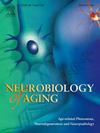Hypothalamic imaging in Alzheimer’s disease and Lewy body dementia: A systematic review and meta-analysis
IF 3.5
3区 医学
Q2 GERIATRICS & GERONTOLOGY
引用次数: 0
Abstract
Symptoms related to sleep, weight, and endocrine dysfunction are common in Alzheimer’s disease (AD) and Lewy body dementia (LBD). The cause of these symptoms is not known, but they may be related to hypothalamic neurodegeneration. We performed a systematic search of MEDLINE and EMBASE for studies using MRI or PET imaging to examine the hypothalamus in AD or LBD. The Newcastle-Ottawa scale was used to assess the risk of bias. A random-effects meta-analysis was conducted using the standardised mean difference (SMD) in hypothalamic volume, and a narrative synthesis was used to examine associations between hypothalamic imaging and sleep, weight, and endocrine function. We screened 8891 articles which identified 22 studies for inclusion in the narrative synthesis of which 6 were suitable for meta-analysis. 86 % had a low to moderate risk of bias. People with mild-moderate AD had a smaller hypothalamus compared to controls (SMD=-0.49[-0.86,-0.13],p = 0.018;I2=67 %[21.5 %-86.1 %];n = 454(AD),715(controls)), and had differences in hypothalamic metabolism and connectivity. Two studies in LBD found lower grey matter and serotonin transporter binding in the hypothalamus compared to controls. Hypothalamic differences in AD were associated with male sex, worse sleep, lower bone mineral density and plasma levels of sex hormones. Body mass index was not associated with hypothalamic volume in AD, although further studies are needed. Lower hypothalamic volume is seen in AD and this may influence sleep and endocrine function. A better understanding of hypothalamic degeneration may help elucidate how pathology relates to symptoms in AD and LBD and reveal new targets for intervention.
阿尔茨海默病和路易体痴呆的下丘脑成像:系统回顾和荟萃分析
与睡眠、体重和内分泌功能障碍相关的症状在阿尔茨海默病(AD)和路易体痴呆(LBD)中很常见。这些症状的原因尚不清楚,但它们可能与下丘脑神经变性有关。我们在MEDLINE和EMBASE中进行了系统的搜索,寻找使用MRI或PET成像检查AD或LBD患者下丘脑的研究。纽卡斯尔-渥太华量表用于评估偏倚风险。使用下丘脑体积的标准化平均差(SMD)进行随机效应荟萃分析,并使用叙事综合来检查下丘脑成像与睡眠、体重和内分泌功能之间的关系。我们筛选了8891篇文章,确定了22项研究纳入叙事综合,其中6项适合进行meta分析。86% %具有低至中等偏倚风险。与对照组相比,轻度-中度AD患者下丘脑较小(SMD=-0.49[-0.86,-0.13],p = 0.018;I2=67 %[21.5 %-86.1 %];n = 454(AD),715(对照)),下丘脑代谢和连通性存在差异。两项关于LBD的研究发现,与对照组相比,下丘脑的灰质和血清素转运体结合较低。阿尔茨海默病的下丘脑差异与男性、较差的睡眠、较低的骨密度和血浆性激素水平有关。身体质量指数与阿尔茨海默病患者的下丘脑体积无关,但还需要进一步的研究。阿尔茨海默病患者下丘脑体积较低,这可能影响睡眠和内分泌功能。更好地了解下丘脑变性可能有助于阐明病理与AD和LBD症状的关系,并揭示新的干预靶点。
本文章由计算机程序翻译,如有差异,请以英文原文为准。
求助全文
约1分钟内获得全文
求助全文
来源期刊

Neurobiology of Aging
医学-老年医学
CiteScore
8.40
自引率
2.40%
发文量
225
审稿时长
67 days
期刊介绍:
Neurobiology of Aging publishes the results of studies in behavior, biochemistry, cell biology, endocrinology, molecular biology, morphology, neurology, neuropathology, pharmacology, physiology and protein chemistry in which the primary emphasis involves mechanisms of nervous system changes with age or diseases associated with age. Reviews and primary research articles are included, occasionally accompanied by open peer commentary. Letters to the Editor and brief communications are also acceptable. Brief reports of highly time-sensitive material are usually treated as rapid communications in which case editorial review is completed within six weeks and publication scheduled for the next available issue.
 求助内容:
求助内容: 应助结果提醒方式:
应助结果提醒方式:


